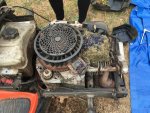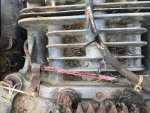Hello everyone. My mower's engine is a Kohler Courage 19. The engine won't crank. I opened things up and found a nice mouse nest:

After clearing the nest I found:

As you can see, the mouse gnawed through the pink wire completely. The black wire leading from the ignition module to the spark plug survived.
What is the function of the pink wire? It seems to lead to the carburetor. How can I fix it?
Thank you!

After clearing the nest I found:

As you can see, the mouse gnawed through the pink wire completely. The black wire leading from the ignition module to the spark plug survived.
What is the function of the pink wire? It seems to lead to the carburetor. How can I fix it?
Thank you!
